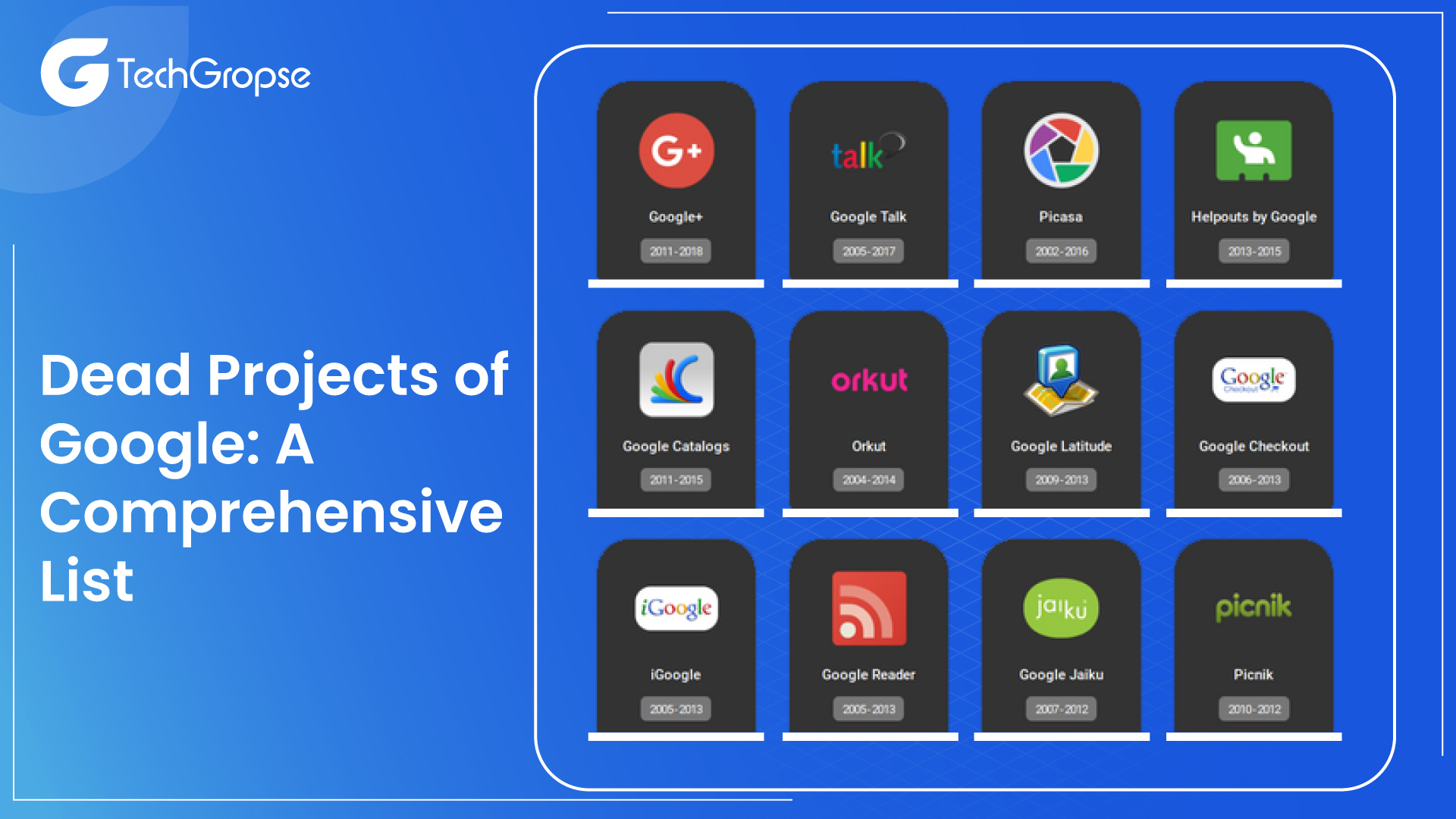Google is a company known for innovation, constantly experimenting with new projects and technologies. However, not every project is successful, and some have been left to die a slow death in what has become known as the Google Graveyard.
We are all aware, Google is no stranger to innovation and experimentation, constantly producing the latest products and mobile app development services to enhance our digital lives.
However, not every project has struck a chord with the public or achieved the success of the company’s most popular products.
Here we will discuss the dead google products services that have been created, launched, and discontinued for some reasons.
Introduction: The Google Graveyard
In the past two decades, Google has become a household name that has transformed the way we search, communicate, and access information.
While Google has introduced various successful products and services that have changed the world like Gmail, Google Maps, and YouTube.
From Google Plus to Google Glass, the tech company has shut down various ambitious projects that failed to fulfill user expectations and business objectives.
In this post, we will move into the Google Graveyard and evaluate some of the dead projects of Google, the reasons behind their failure, and the lessons we can learn from them.
Dead Projects of Google: A Comprehensive List

Google is one of the world’s most renowned tech industries that have given users some of the services that helped change the way we use the internet today. Nevertheless, with success comes failure.
Although many projects have come and gone, they highlight Google’s willingness to take risks and explore new technologies.
It is thrilling to see that some products such as GSuite or Google Home are still standing strong today. Let’s start to learn more about Google Graveyard!
1. Google Reader
Google Reader was a well known RSS feed aggregator that was introduced in 2005. This was one of the most popular RSS readers of its time. However, in 2013, Google announced that it was closing down the service because of a decline in usage.
However, despite petitions from users who loved the service, Google insisted that the service was not being used. At the time of discontinuation, the number of daily active users of that service widened.
It was a sad loss for users who relied on it to stay updated with current news and updates from their favorite news outlets.
2. Google Buzz
Google Buzz is another product that was discontinued by Google. Google Buzz was a social networking service that aimed to compete with Facebook and Twitter.
It was introduced to compete with Facebook as a social networking service, but despite being a fantastic idea, it turned into a customer service disaster for the tech industry.
With the initial setup of this service, it compromised user privacy by disclosing contact lists in public comments by default.
This led to a huge scrutiny from the public and government entities, and subsequently the end of the service. However, it was troubled by privacy issues and was eventually shut down in 2011.
3. Google Glass
Google Glass is another service that has a significant history. It was introduced in 2013, and despite the hype, it was discontinued a year later.
Glass was an excellent conceptually fashion-forward wearable, designed to help overlay information on the human field of vision, enhancing the experience of everyday life.
Google Glass was a wearable device that offered users access to the internet and took photos and videos. Despite creating a lot of buzz when it was first introduced, the product failed to achieve traction with consumers and was discontinued in 2015.
Still, it did not appeal to the masses. While the product had various issues, the high price tag was a massive turn off to most consumers. It was eventually discontinued due to a lack of interest from the public.
4. Google Wave
Google Wave was a product introduced in 2009, with the concept of offering users to combine e-mails, message boards, and wikis in one place. Google Wave was designed to be a collaborative tool that helped users work together in real-time.
Google Wave was a collaboration platform that combined email, instant messaging, and document sharing. However, it struggled to get acceptance from users and was closed down in 2012.
Despite the hype, the product was discontinued just thirteen months after launch, and this disinterest came shortly after the product launch. It was clear that people were not sure how to use it or weren’t interested in what it had to offer.
5. Google Plus
Google Plus was a social networking platform that aimed to compete with Facebook. With its intuitive design and seamless integration with other Google services, it is the perfect solution for any professional or individual looking to connect with others in a meaningful way.
Despite a significant investment in the product, it failed to attract users and was eventually shut down in 2019. It also faced huge privacy concerns and accusations of being a forced add-on for YouTube users.
It is disappointing that the company was not able to make this project successful, but at least they learned from their mistakes and continue to innovate and improve in other areas.
Want to learn more about Google Graveyard in Saudi Arabia? Check out: mobile app development company saudi arabia
Google Graveyard: Reasons for Project Failures

It is exciting and heartbreaking at the same time. Essentially, it is a list of all the projects that Google has shut down due to failure or lack of success. But why do these projects ultimately fail?
Well, there are several reasons of the Google Graveyard that could not attract people including:
1. Too Much Innovation, Too Little Focus
One of the important reasons for project failures at Google is the company’s preference for frequently experimenting with the latest ideas. While this is commendable, it can also become a liability when there is too much innovation without a clear focus. When there are too many ideas and not enough resources to pursue them, many projects end up being half-baked and ultimately fail.
2. Market Saturation and Intense Competition
Google operates in a highly competitive environment, and many of its projects have been introduced in markets that are already saturated with established players. When faced with intense competition, it can be challenging to get a foothold in the market and attract users or customers.
3. Lack of User Adoption and Engagement
Even if a project has a clear focus and a unique value proposition, it can still fail if users don’t adopt it or engage with it. Getting users to change their behavior and switch to a modern product or service can be challenging, and it needs a significant investment in marketing and user education.
The Impact of Failed Projects on Google’s Business

Google Graveyard is the place where all of Google’s failed projects end up, and it’s fascinating to see just how much effect these unsuccessful ventures have had on such a successful company.
From Google Wave to Google Buzz, even giants like Google Glass took their place in the graveyard. But these failures are not a negative thing. In fact, they suggest how innovative and creative Google is as a company.
1. Financial Implications of Failed Projects
Failed projects can have an essential financial impact on a company, particularly if they have invested significant resources in the project. Google has closed many projects over the years, and the financial implications of these failures are not insignificant.
2. Reputation Damage Control
When a high-profile project fails, it may damage a company’s reputation and erode consumer confidence. Google has a reputation for being a creative and forward-thinking company, and failed projects can tarnish this reputation.
3. Employee Morale and Retention
Failed projects can also have an impact on employee morale, particularly those who have worked on the project. When a project fails, it can be demoralizing for employees and make them less likely to take risks or innovate in the future.
In addition, when a company has a reputation for killing projects, it can make it more challenging to attract and retain top talent.
Also Read: Mobile App Development Company in Chicago
Lessons Learned from the Google Graveyard

It is amazing to see just how much innovation and experimentation goes on behind the scenes at this tech giant. From Wave to Reader, Google has shown that even the best of ideas don’t always make it in the fast-paced world of technology.
But what is inspiring is how Google takes these failures as opportunities for growth and learning. Through GoogleGraveyard, you can see a pattern of creating, testing, and moving on.
People can also learn how crucial it is to stay focused on user needs and to avoid getting too attached to any particular idea or product.
The Google Graveyard is not a place of distress, but rather a goldmine of insights for anyone looking to make impactful products in today’s ever-changing market.
1. Importance of User Feedback and Research
One important lesson we can learn from the dead projects of Google Graveyard is the importance of user feedback and deep research. Google has a huge user base, and yet, some of its projects failed because of a lack of understanding of user needs and behavior. User feedback should be a critical element of any project, and a lack of it can lead to misunderstandings about user behavior and preferences.
2. The Benefits of Experimentation and Risk-Taking
Another lesson we can learn from the Google Graveyard is the advantages of experimentation and risk-taking. Google is well known for its culture of experimentation, and many of its successful projects come out from experimentation and taking risks. Although not every experiment will lead to success, the ones that do can lead to breakthroughs and innovations.
3. Keeping a Focus on Core Business Objectives
Last but not the least, a lesson from the Google Graveyard is the importance of keeping a focus on core business objectives. Some of Google’s dead projects failed due to they were too far away from the company’s core business objectives.
This is not to say that companies should not run after projects outside of their core business objectives, but rather that they should be aware of the risks and potential consequences.
Want to learn more about Google Graveyard in Dubai UAE? Check out: mobile app development company
The Future of Google’s Innovation Strategy
The future of Google’s revolution strategy is one that is incredibly exciting to behold. With a constant focus on developing advanced technology and looking for new and innovative ways to solve complex problems.
The company is composed to continue leading the charge in shaping our digital landscape. From advancements in artificial intelligence and machine learning to moving the boundaries of what we thought was possible with cloud computing, Google’s commitment to innovation is inspiring.
Additionally, their emphasis on sustainability and making meaningful social impact offers hope for a future where technology serves humanity rather than vice versa.
1. Balancing Innovation with Sustainable Growth
Moving ahead, Google requires to balance innovation with continuous growth. The company has a reputation for innovation, but it also needs to ensure that its innovation efforts align with long-term business objectives. Without this balance, Google may search itself with more failed projects in the future.
2. The Role of Google X and Alphabet Inc.
Google X and Alphabet Inc. play an essential role in Google’s innovation strategy. Google X is the company’s moonshot factory, tasked with exploring ambitious, futuristic ideas. Alphabet Inc. is Google’s parent company, and it offers the company with the resources and flexibility to pursue projects outside of its core business. By leveraging these entities, Google may continue to create amazing ideas while managing risk.
3. Opportunities for Future Success
There are many opportunities for Google to achieve future success. The company has a huge user base and a wealth of data that it can use to drive innovation. Additionally, emerging technologies such as artificial intelligence and virtual reality give the latest opportunities for Google to explore. By continuing to innovate and experiment, Google can position itself for long-term success.
The Closing Words
Overall, the Google Graveyard teaches us the essential of failure in innovation. Failure is not always a bad thing; it can lead to valuable appreciation and lessons for future innovation efforts.
Without failure, innovation can become stagnant, and companies can miss out on opportunities for growth and success.
Google, with its vast pool of resources, will continue to innovate and create more products for the world. However, some products don’t become a significant success for the public.
Also Read: best app development company in Atlanta
FAQ: Google Graveyard – The Dead Projects of Google
Why has Google shut down so many projects?
Google is popular for experimentation and innovation that encourages its employees to test and introduce new products and services frequently. However, this also means that Google launches many products that fail to attract users or create significant revenue.
What is Google’s approach to innovation?
The company has created a variety of programs and initiatives aimed at fostering innovation, such as Google X, its secretive research lab, and Alphabet Inc., its parent company that invests in a huge range of industries. Google’s approach to innovation is to motivate a bottom-up approach, where employees are encouraged to pursue their great ideas and initiatives.
What lessons can we learn from the Google Graveyard?
The Google Graveyard serves as a reminder that even the most innovative companies can experience failures. Some of the key lessons we can learn from the Google Graveyard include the importance of user feedback and research, the need to balance experimentation with sustainable growth, and the benefits of keeping a focus on core business objectives.
What is the future of innovation at Google?
Some of the areas where Google is likely to innovate like artificial intelligence, virtual and augmented reality, and cloud computing. However, Google will require to balance its innovative spirit with constant growth and consider the lessons learned from the failures of the past to continue to be successful.
Which were some of the most popular projects that Google ended up canceling?
Google has had so many amazing projects over the years! Some of the most popular ones that come to mind include Google Glass, Google Wave, and Google Reader.
Many companies turn to a skilled mobile app developer Los Angeles to help navigate the challenges of maintaining an app in Google’s ever-evolving ecosystem.






